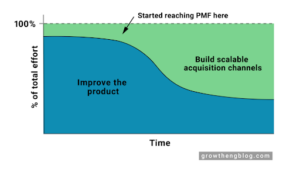A data strategy ensures that all pieces of the business are working together with and from the same information. With a data strategy in place, you can be confident that teams and departments are not duplicating efforts because your data is regularly collected and centralized.

A codified data strategy also makes the process of data governance – ensuring the security and proper handling of all business data – much easier, which alleviates some level of legal risk.
The right data strategy for your business will depend largely on your industry, business goals, and internal organization.
Keep reading to learn how to build, refine, and utilize a data strategy that will work for your industry.
1. Assess company culture
A successful data strategy cannot be built on a culture that does not trust and value data. A data-driven culture is one that relies on data to answer questions and make decisions, eliminating the emotion and speculation that can easily creep into the decisions-making processes, particularly in start-ups.
To start building your data strategy, take an honest look at your company culture. If you are not driven by data, you’ll want to figure out why not. Some common reasons may be:
- You have no sound data infrastructure, so collecting data is time-consuming and unreliable
- There is no single source of truth, so it is too difficult to cobble together usable data
- When data comes from multiple sources that use different methodologies and measurements, insights are inconsistent and unreliable
- Data is inaccessible to the majority of users within your organization
- You have not invested in data visualization tools to make data understandable or accessible
- Your data culture does not have buy-in from all key players
If you can start to address some of the outstanding issues, you can begin to build (or reinforce) your data-driven culture. It’s not a change that can happen overnight but as you build out a data infrastructure that makes it easy to see just how powerful your data can be, you are likely to get more buy-in at every level and strengthen your position.
2. Identify data strategy goals and KPIs
As with any strategy-building process, you’ll want to have a clear sense of your “why” as you build out your data strategy. What do you hope to be able to accomplish with a functioning data strategy and how will you know if you’ve achieved it?
Some example questions that may be helpful:
- What elements of data strategy are already in place? How can they be improved? For instance, when you’re at the step of creating a data strategy, you’re likely already collecting quite a bit of data. Which tools are working? Why or why not? Is that data actually usable or would an additional layer of tooling, such as an ETL tool, make that data more accessible?
- Who will design and implement the data strategy? If you already have a data team (even a team of one) in place, it may be obvious. At this stage, you may not have dedicated data experts, and that’s okay. Focus on the big picture of what you want to learn from your data and how you plan to directly apply data to your business goals.
- What will the auditing process be? An auditing process is essential for any new strategic implementation. At regular intervals, you’ll want to make sure that your data strategy is helping you achieve your measurable goals and be able to identify when and where it isn’t helping so that you can make updates as necessary.
As you ask and answer these questions, be specific to your industry. For instance, in the ecommerce space you may be most interested in which of your products are performing best month-to-month. You can use the data you’re already collecting to learn what specifically users are buying over and over and to build better products by leveraging what you now know, whether that means expanding options for popular and profitable products, restocking faster, or letting less popular products fall off.
As your data strategy matures and your organization has a clearer picture of what data you actually have and how it can be useful, it is quite possible that you will be able to answer questions you did not even anticipate.
3. Consider your data sources
Your data strategy should incorporate your current data sources as well as take into account data sources that may become relevant in the near future.
If you’re actively working towards an effective data strategy, it means that you’re ready to move away from leveraging your data inside the tools that are creating that data and into a process that is more holistic. When your data is locked away inside of each tool’s silo, it is more difficult to garner insights from that data, since data from one tool is so often deeply linked to data from another. For instance, you might learn from your site analytics that traffic to a certain landing page has dropped, but if you don’t have the data from your ad spend to say that a campaign directing users to that page ended recently, you can easily go on a wild goose chase trying to figure out why.
This is when a modern data stack becomes more than a convenience.
A tool like Mozart Data, which allows you to collect and query data from hundreds of sources, then transform it into usable insights, is critical for a successful long-term data strategy. You’ll want to find a tool that not only supports the data sources you currently rely on, but that can grow with you as well.
Being able to leverage data from across your data sources comes with the benefit of allowing teams across your organization access to usable data as well. No matter how much data you collect, it is useless if the right teams cannot access and interpret it for their big picture goals.
For instance, data-driven marketing can only be achieved when your marketing team can access and interpret data about your customers, products, site performance, and whatever else may be relevant in your particular industry. A robust data strategy should allow you to dive deep into segmenting your customer base. A DTC company may already be doing the minimum by looking at, for example, customers grouped together by when they became a customer (day, month, quarter). With the right tools in place, those customers can and should be rearranged and reanalyzed in as many contexts as makes sense for your business: products purchased and repurchased, discount codes used, referrals made, etc. to uncover which customers are really driving the growth of your business so you can make smart investments go forward.
4. Match data sources with KPIs
When it comes to data strategy, it can be a major challenge for a lot of teams to actually get to the point of collecting insights. Without a strategy in place, it can be easy to shuffle data from one place to another and feel like something “data-driven” is happening when it’s really not.
For example, a new B2B business may be struggling with finding product-market fit. There are a million ways to throw something at the wall and see what sticks, but when you have a full picture of what the data is telling you, you don’t have to waste time testing them all out. Instead, you can measure exactly how users are engaging with your product, where they’re coming from, when they’re leaving, and whatever else you need to know to make an informed decision about where your business goes next. Something as simple as studying the differences in behaviors between users who arrived on your site from organic search and those that came in through your advertising efforts can provide numerous insights to inform your sales strategy.
The goal is ultimately to use data to help make forward-thinking business decisions that will support growth and profitability. It can take some time to get to this juncture. Many teams begin using data to figure out what went wrong before they get to a place where they can use it more predictively to stop catastrophes before they occur.
Once you are familiar with your data sources and what you’re hoping to glean from your data analysis, you’ll need to make sure that you’re set up to actually uncover the insights you want. A big part of being able to analyze data effectively is data visualization, which typically comes in the form of a business intelligence (BI) tool. A BI tool only becomes useful once you have established a clean and reliable single source of truth from which to create data visualizations. The impact of an effective BI tool is huge: it can give less technical people access to data that makes sense to them and can let virtually anyone view and understand complex data without getting mired in the raw numbers.
5. Define data governance measures
Data governance must be a part of any successful data strategy. As your data strategy matures, you will likely be collecting, storing, and analyzing even more data than you are today, which means the sooner effective data governance measures are implemented, the easier it will be. Consider questions such as:
- What are proper, legal storage procedures for your data?
- Who will ensure that proper storage is being observed?
- Who currently has access to what data? Who might need access in the future?
- Do you collect and/or store any personal identifying information (PII)? If so, does everyone need access to it?
The answers to these questions will vary widely depending on your business. For instance, if you have any healthcare slant to your business the data you collect may be subject to HIPAA regulations. Similarly, the banking and finance industries have laws specifically governing the data they collect and store.
For most companies that are not in an industry with specialized regulations there are still laws like GDPR to consider. Being explicit about your data governance procedures in your data strategy can save you a tremendous amount of headache in the long term.
6. Review and refine
Like so many digital strategies, your data strategy should never be looked at as being set in stone. Rather, it is a living thing that will change as the needs of your business, your access to new technologies, and even laws that govern data change. That’s why there should be a mechanism within your data strategy that allows for you to review and refine it at regular intervals. Make sure to include stakeholder feedback about what may or may not work about the current iteration so you can work together to improve the strategy with each passing revision.
Building out a data strategy means taking a lot of moving parts into account. As long as you keep an eye towards the ultimate goals of the strategy – a data-driven business that makes decisions based on much more than a gut feeling – you’ll be able to keep building on each success.
If you’re ready to take the next step towards building your company on the foundation of good data, contact Mozart Data to schedule a demo. We have expert data analyst support on hand to help you build out a data strategy that makes sense for your industry and your specific business goals.


